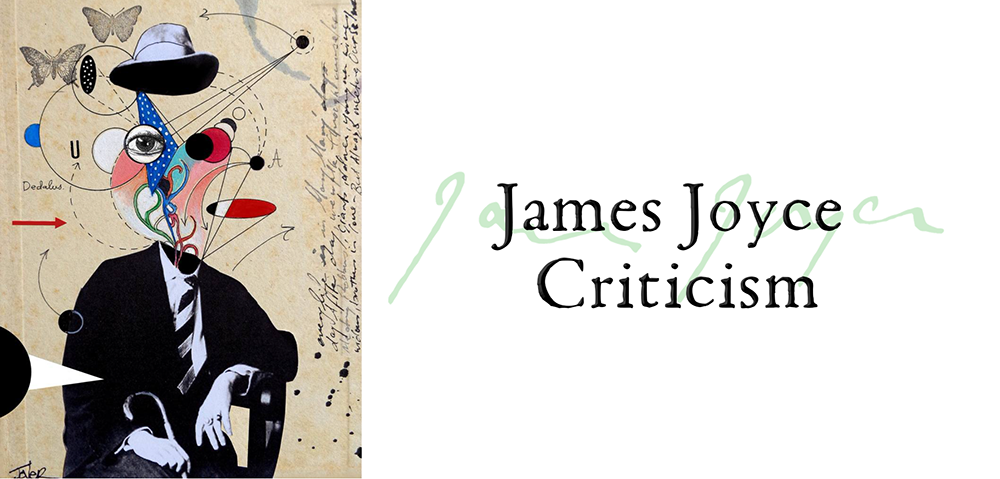Joyce Criticism: General 4: 2020-Present
- At June 13, 2023
- By Great Quail
- In Joyce
 0
0
General Joyce Criticism: 2020-Present
The works profiled below are criticism about Joyce and his entire oeuvre, rather than any specific work. This section details works written from 2020 to the present—about 99% of them published by Bloomsbury Academic, it seems! The books are listed by publication date. Clicking a cover image takes you to Amazon.com. When Brazen Head commentary is unavailable, the publisher’s summaries are usually reprinted. Many of these profiles contain links to detailed reviews published in the James Joyce Quarterly or other academic journals. Unfortunately, most of these are gated behind a JSTOR or Project MUSE paywall. If any knowledgeable Joyce reader would like to review, summarize, or provide additional information for any of these “uncommented” books, please drop us a line! Additional “general” criticism may be found by clicking the links below.
General Joyce Criticism
[Main Page | Criticism 1924-1979 | Criticism 1980-1999 | Criticism 2000-2019 | Criticism 2020-Present]
Music and Sound in the Life and Literature of James Joyce: Joyces Noyces
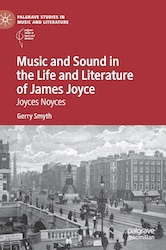
Music and Sound in the Life and Literature of James Joyce: Joyces Noyces
By Keith Williams
Palgrave Macmillan, 2020
Publisher’s Description: Music and Sound in the Life and Literature of James Joyce: Joyces Noyces offers a fresh perspective on the Irish writer James Joyce’s much-noted obsession with music. This book provides an overview of a century-old critical tradition focused on Joyce and music, as well as six in-depth case studies which revisit material from the writer’s career in the light of new and emerging theories. Considering both Irish cultural history and the European art music tradition, the book combines approaches from cultural musicology, critical theory, sound studies and Irish studies. Chapters explore Joyce’s use of repetition, his response to literary Wagnerism, the role and status of music in the aesthetic and political debates of the fin de siècle, music and cultural nationalism, ubiquitous urban sound and “shanty aesthetics.” Gerry Smyth revitalizes Joyce’s work in relation to the “noisy” world in which the author wrote (and his audience read) his work.
Reviews: Annika J. Lindskog’s review of Music and Sound in the Life and Literature of James Joyce appears in the James Joyce Quarterly, Vol. 59, No. 2 (Winter 2022), pp. 369–372, [Project MUSE paywall].
James Joyce and Cinematicity: Before and After Film
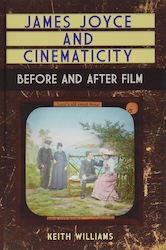
James Joyce and Cinematicity: Before and After Film
By Keith Williams
Edinburgh University Press, 2020
Publisher’s Description: In this book, Keith Williams explores Victorian culture’s emergent “cinematicity” as a key creative driver of Joyce’s experimental fiction, showing how Joyce’s style and themes share the cinematograph’s roots in Victorian optical entertainment and science. The book reveals Joyce’s references to optical toys, shadowgraphs, magic lanterns, panoramas, photographic analysis and film peepshows. Close analyses of his works show how his techniques elaborated and critiqued their effects on modernity’s “media-cultural imaginary.”
Reviews: Jeffrey Longacre’s review of James Joyce and Cinematicity appears in the James Joyce Quarterly, Vol. 58, No. 1–2 (Fall 2020–Winter 2021), pp. 209–213, [Project MUSE paywall].
All Future Plunges to the Past: James Joyce in Russian Literature
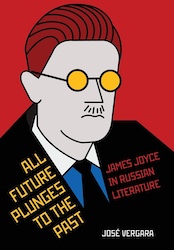
All Future Plunges to the Past: James Joyce in Russian Literature
By José Vergara
Northern Illinois University Press, 2021
Publisher’s Description: All Future Plunges to the Past explores how Russian writers from the mid-1920s on have read and responded to Joyce’s work. Through contextually rich close readings, José Vergara uncovers the many roles Joyce has occupied in Russia over the last century, demonstrating how the writers Yury Olesha, Vladimir Nabokov, Andrei Bitov, Sasha Sokolov, and Mikhail Shishkin draw from Joyce’s texts, particularly Ulysses and Finnegans Wake, to address the volatile questions of lineages in their respective Soviet, émigré, and post-Soviet contexts. Interviews with contemporary Russian writers, critics, and readers of Joyce extend the conversation to the present day, showing how the debates regarding the Irish writer’s place in the Russian pantheon are no less settled one hundred years after Ulysses. The creative reworkings, or “translations,” of Joycean themes, ideas, characters, plots, and styles made by the five writers Vergara examines speak to shifting cultural norms, understandings of intertextuality, and the polarity between Russia and the West. Vergara illuminates how Russian writers have used Joyce’s ideas as a critical lens to shape, prod, and constantly redefine their own place in literary history. All Future Plunges to the Past offers one overarching approach to the general narrative of Joyce’s reception in Russian literature. While each of the writers examined responded to Joyce in an individual manner, the sum of their methods reveals common concerns. This subject raises the issue of cultural values and, more importantly, how they changed throughout the twentieth century in the Soviet Union, Russian emigration, and the post-Soviet Russian environment.
Reviews: Peter Barta wrote an unfavorable review of All Future Plunges to the Past in the Slavonic and East European Review, Vol. 100, No. 4 (October 2022), pp. 749–751, [Project MUSE paywall]. According to Barta, “Contrary to expectations that the title and jacket may well elicit, the book makes virtually no contribution of any note to scholarship on James Joyce. The author demonstrates undoubted expertise about the Russian writers and the researched academic publications they generated. Sufficient knowledge of the relevant secondary literature on Joyce, however, is less evident. The bibliography of non-Russian related sources, including Joyce, is limited and dated.” Nataliya Karageorgos’s more favorable review appeared in the LARB on 22 February 2022.
Hope, Form, and Future in the Work of James Joyce
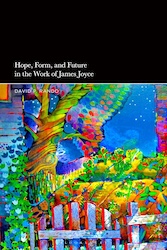
Hope, Form, and Future in the Work of James Joyce
By David P. Rando
Bloomsbury Academic, 2021
Publisher’s Description: Hope and future are not the terms with which James Joyce has usually been read, but this book paints a picture of Joyce’s fiction in which hope and future assume the primary colours. Rando explores how Joyce’s texts, as early as Dubliners and A Portrait of the Artist as a Young Man, delineate a complex hope that is oriented toward the future with restlessness, dissatisfaction, and invention. He examines how Joyce envisions alternatives to the prevailing conventions of hope throughout his works and, in Ulysses and Finnegans Wake, develops formal techniques of spatializing hope to contemplate it from all sides. Casting fresh light on the ways in which hope animates key aspects of Joyce’s approach to literary content and form, Rando moves beyond the limitations of negative critique and literary historicism to present a Joyce who thinks agilely about the future, politics, and possibility.
Reviews: Margot Norris’ review of Hope, Form, and Future in the Work of James Joyce appeared in the James Joyce Quarterly, Vol. 60, No. 3 (Spring 2022), pp. 399–402, [Project MUSE paywall]. Norris called the book a “remarkably innovated exploration” filled with “substantial discussions.” Anna Dijkstra offered another positive review in The Modernist Review on 30 September 2022, finding Rando’s themes of hope both “encouraging” and “subversive” in the post-COVID age.
At Fault: Joyce and the Crisis of the Modern University
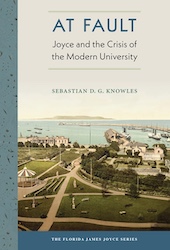
At Fault: Joyce and the Crisis of the Modern University
By Sebastian D.G. Knowles
University Press of Florida, 2021
Publisher’s Description: At Fault is an exhilarating celebration of risk-taking in the work of James Joyce. Esteemed Joyce scholar and teacher Sebastian Knowles critiques the state of the modern American university, denouncing what he sees as an accelerating trend of corporatization that is repressing discussions of controversial ideas and texts in the classroom. Arguing that Joyce offers the antidote to risk-averse attitudes in higher education, he shows how the modernist writer models an openness to being “at fault” that should be central to the academic enterprise. Knowles describes Joyce’s writing style as an “outlaw language” imbued with the possibility and acknowledgment of failure. He demonstrates that Joyce’s texts and characters display a drive to explore the boundaries of experience, to move outward in a centrifugal pattern, to defy delimitation. Knowles further highlights the expansiveness of Joyce’s world by engaging a diverse range of topics, including Jumbo the elephant as a symbol of imperialism, the gramophone as a representation of the machine age, solfège and live music performance in the “Sirens” episode of Ulysses, Joyce’s jokes and the neurology of humor, and inventive ways of reading and teaching Finnegans Wake. Contending that error is the central theme in all of Joyce’s work, Knowles argues that the freedom to challenge boundaries and make mistakes is essential to an effective learning environment. Energetic and delightfully erudite, and offering insights drawn from over thirty years of classroom experience, Knowles inspires readers with the infinite possibilities of free human thought exemplified by Joyce’s writing.
Reviews: Colleen Jaurretche’s review of At Fault appeared in the James Joyce Quarterly, Vol. 57, No. 1–2 (Fall 2019-Winter 2020), pp. 200–203, [Project MUSE paywall].
Attachment and Loss in the Works of James Joyce
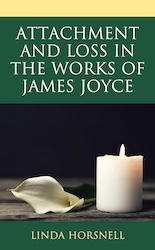
Attachment and Loss in the Works of James Joyce
By Linda Horsnell
Lexington Books, 2021
Publisher’s Description: Using John Bowlby’s Attachment Theory as a frame of reference, Attachment and Loss in the Works of James Joyce critically analyzes James Joyce’s representation of grief. Based on cognitive, emotional and behavioral elements, Attachment Theory allows for new and innovative readings to emerge which differ from those offered by Freudian, Lacanian, and Jungian paradigms. Acknowledging the importance of the Theory of Mind and Reader Response, this book uses the concept of internal working models to elucidate how the childhood experiences with which Joyce has endowed his protagonists ultimately leads to how they respond to loss. The texts of Dubliners, Portrait of the Artist and Ulysses, show how central separation and loss were to Joyce’s work. It provides examples of such experiences in different age groups, under differing circumstances and at different stages in the grief process. Attachment Theory highlights the complexity of human relationships throughout the life cycle, not only how they can affect the grief process but how grief affects them.
James Joyce: A Very Short Introduction

James Joyce: A Very Short Introduction
By Colm MacCabe
Oxford University Press, 2022
Publisher’s Description: This Very Short Introduction explores the work of this most influential yet complex writer, and analyses how Joyce’s difficulty grew out of his situation as an Irish writer unwilling to accept the traditions of his imperialist oppressor, and contemptuous of the cultural banality of the Gaelic revival. Joyce wanted to investigate and celebrate his own life, but this meant investigating and celebrating the drunks of Dublin’s pubs and the prostitutes of Dublin’s brothels. No subject was alien to him and he developed the naturalist project of recording all aspects of life with the symbolist project of finding significant correspondences in the most unlikely material. Throughout, Colin MacCabe interweaves Joyce’s life and history with his books, and draws out their themes and connections.
Joyce Writing Disability
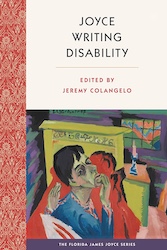
Joyce Writing Disability
Edited by Jeremy Colangelo
University of Press of Florida, 2022
Publisher’s Description: In this book, the first to explore the role of disability in the writings of James Joyce, contributors approach the subject both on a figurative level, as a symbol or metaphor in Joyce’s work, and also as a physical reality for many of Joyce’s characters. Contributors examine the varying ways in which Joyce’s texts represent disability and the environmental conditions of his time that stigmatized, isolated, and othered individuals with disabilities. The collection demonstrates the centrality of the body and embodiment in Joyce’s writings, from Dubliners and A Portrait of the Artist as a Young Man to Ulysses and Finnegans Wake. Essays address Joyce’s engagement with paralysis, masculinity, childhood violence, trauma, disorderly eating, blindness, nineteenth-century theories of degeneration, and the concept of “madness.” Together, the essays offer examples of Joyce’s interest in the complexities of human existence and in challenging assumptions about bodily and mental norms. Complete with an introduction that summarizes key disability studies concepts and the current state of research on the subject in Joyce studies, this volume is a valuable resource for disability scholars interested in modernist literature and an ideal starting point for any Joycean new to the study of disability.
Contents:
- Jeremy Colangelo, “Introduction: Disability Writing Joyce”
- Jeremy Colangelo, “Two Sides of Hemiplegia: On the Affect of Paralysis in Dubliners”
- Casey Lawrence, “Limping and Devious: The Disabled Male Body in ‘A Mother’”
- Boriana Alexandrova, “When the Personal Becomes Historical: Portrait and the Textual Memory of Childhood Trauma”
- Kathleen Morrissey, “Debility as Disability: Disorderly Eating in A Portrait of the Artist as a Young Man”
- Rafael Hernandez, “Dark Men in Mien and Movement: Blindness and the Body in Ulysses”
- Marion Quirici, “Degeneration, Decadence, and Joyce’s Modernist Disability Aesthetics”
- John Morey, “Boulez, Cage, and the Disabled Wake”
- Giovanna Vincenti, “Joyce, Swift, and the ‘Creep o’er Skull’ of the Gods”
- Jennifer Marchisotto, “The Anti-Erasure of Lucia Joyce: Resignification of Mad Histories in Finnegans Wake”
Reviews: Jan Shelton’s review of Joyce Writing Disability appeared in the James Joyce Quarterly, Vol. 60, No. 1–2 (Fall 2022–Winter 2023), pp. 185–188, [Project MUSE paywall].
Multiple Joyce
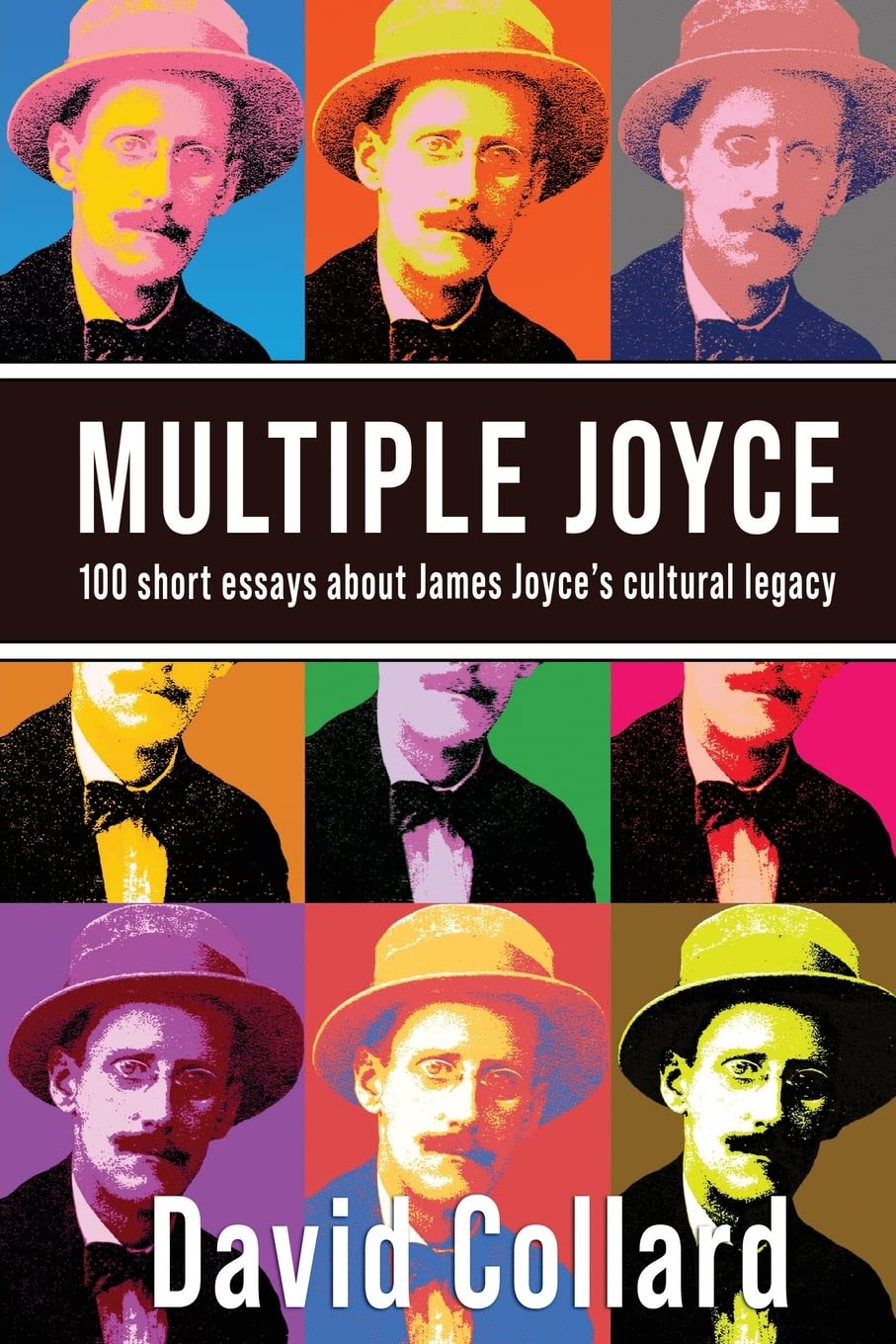
Multiple Joyce
By David Collard
Sagging Meniscus Press, 2022
Publisher’s Description: In one hundred short essays David Collard navigates James Joyce’s astonishing cultural legacy in the century since the publication of Ulysses in 1922. Holding up a funhouse mirror to our times, Collard finds a multitude of Joyces, in often ludicrous disguises, wherever he looks-whether at Ally Sloper, Borsalino hats, Anthony Burgess, Cher, first editions, Flann O’Brien, Guinness, Hattie Jacques, John Cage, Kim Kardashian, Lego, Moby-Dick, numismatics, perfume, pianos, Princess Grace, puns, The Ramones, Sally Rooney, Stanley Unwin, Star Wars, waxworks or Zylo spectacles. Endlessly reinvented and exploited, Joyce emerges as a ubiquitous, indispensable and ruthlessly commodified Everyman. As Rónán Hession puts it in his foreword, Collard is above all “good company.” Whether you’re a devout admirer or wary newcomer, this surprising, unconventional handbook offers an entertaining prompt to dive into the depths of Joyce’s ever-expanding universe with a new awareness that it is very much our own.
James Joyce and Photography
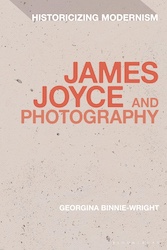
James Joyce and Photography
By Georgina Binnie-Wright
Bloomsbury Academic, 2022
Publisher’s Description: James Joyce and Photography is the first book to explore in-depth James Joyce’s personal and professional engagement with photography. Photographs, photographic devices and photographically-inspired techniques appear throughout Joyce’s work, from his narrator’s furtive proto-photographic framing in Silhouettes (c. 1897), to the aggressively-minded “Tulloch-Turnbull girl with her coldblood kodak” in Finnegans Wake (1939). Through an exploration of Joyce’s manuscripts and photographic and newspaper archival material, as well as the full range of his major works, this book sheds new light on his sustained interest in this visual medium. This project takes Joyce’s intention in Dubliners (1914) to “betray the soul of that hemiplegia or paralysis which many consider a city” as key to his interaction with photography, which in his literature occupies a dual position between stasis and innovation.
James Joyce and the Internal World of the Replacement Child
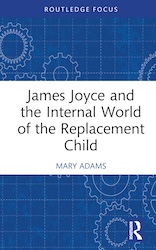
James Joyce and the Internal World of the Replacement Child
By Mary Adams
Routledge, 2022
Publisher’s Description: This book is an exploration of the internal world of James Joyce with particular emphasis on his being born into his parents’ grief at the loss of their firstborn son, offering a new perspective on his emotional difficulties. Mary Adams links Joyce’s profound sense of guilt and abandonment with the trauma of being a ‘replacement child’ and compares his experience with that of two psychoanalytic cases, as well as with Freud and other well-known figures who were replacement children. Issues such as survivor guilt, sibling rivalry, the “illegitimate” replacement son, and the “dead mother” syndrome are discussed. Joyce is seen as maturing from a paranoid, fearful state through his writing, his intelligence, his humour and his sublime poetic sensibility. By escaping the oppressive aspects of life in Dublin, in exile he could find greater emotional freedom and a new sense of belonging. A quality of claustrophobic intrusive identification in Ulysses contrasts strikingly with a new levity, imaginative identification, intimacy and compassion in Finnegans Wake. James Joyce and the Internal World of the Replacement Child highlights the concept of the replacement child and the impact this can have on a whole family. The book will be of interest to psychoanalysts, psychoanalytic psychotherapists and child psychotherapists as well as students of English literature, psychoanalytic studies and readers interested in James Joyce.
James Joyce’s Mandala
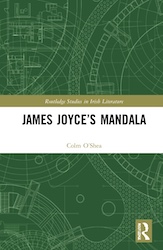
James Joyce’s Mandala
By Colm O’Shea
Routledge, 2022
Publisher’s Description: The Sanskrit word mandala can be translated as “sacred circle.” Within the circle sits a microcosm of the universe and/or consciousness, represented by icons. Eastern civilizations developed the spiritual-artistic practice of creating mandalas―with sand, paint, and architecture―to high technical sophistication, making manifest a geometry with layers of esoteric meaning for both the mandala artist and the initiated spectator. James Joyce’s Mandala outlines and explains this iconic sacred geometry, and assesses to what extent Joyce’s works of literature, in particular Finnegans Wake, can be understood as mandalic constructs. Using exam-ples from Dubliners to the Wake, we see how fundamental to Joyce’s fiction is the issue of spiritual paralysis (a problem the mandala attempts to dissolve) and also how fascinated he was by geometric imagery and symmetry, the technical devices employed in mandala construction. This is the first book-length comparison of Joyce’s work with the mythic structure of the mandala. Never discounting the richness of Joyce’s genius, it uses his “collideorscape” to explore the secrets of the mandala principle as much as it uses mandala theory to illuminate his famed book of the night.
Christian Heresy, James Joyce, and the Modernist Literary Imagination: Reinventing the Word
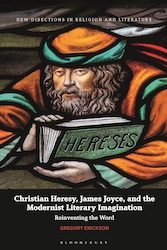
Christian Heresy, James Joyce, and the Modernist Literary Imagination: Reinventing the Word
By Gregory Erickson
Bloomsbury Academic, 2022
Publisher’s Description: Organized by heretical movements and texts from the Gnostic Gospels to The Book of Mormon, this book uses the work of James Joyce–particularly Ulysses and Finnegans Wake–as a prism to explore how the history of Christian heresy remains part of how we read, write, and think about books today. Erickson argues that the study of classical, medieval, and modern debates over heresy and orthodoxy provide new ways of understanding modernist literature and literary theory. Using Joyce’s works as a springboard to explore different perspectives and intersections of 20th century literature and the modern literary and religious imagination, this book gives us new insights into how our modern and “secular” reading practices unintentionally reflect how we understand our religious histories.
Reviews: Kelly Chittenden’s review of Christian Heresy, James Joyce, and the Modernist Literary Imagination appeared in Christianity & Literature, Vol. 72, No. 3 (September 2023), pp. 511–514, [Project MUSE paywall].
James Joyce and the Irish Revolution: The Easter Rising as Modern Event
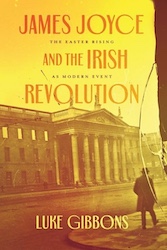
James Joyce and the Irish Revolution: The Easter Rising as Modern Event
By Luke Gibbons
University of Chicago Press, 2023
Publisher’s Description: When revolutionaries seized Dublin during the 1916 Easter Rising, they looked back to unrequited pasts to point the way toward radical futures—transforming the Celtic Twilight into the electric light of modern Dublin in James Joyce’s Ulysses. For Luke Gibbons, the short-lived rebellion converted the Irish renaissance into the beginning of a global decolonial movement. James Joyce and the Irish Revolution maps connections between modernists and radicals, tracing not only Joyce’s projection of Ireland onto the world stage, but also how revolutionary leaders like Ernie O’Malley turned to Ulysses to make sense of their shattered worlds. Coinciding with the centenary of both Ulysses and Irish independence, this book challenges received narratives about the rebellion and the novel that left Ireland changed, changed utterly.
Reviews: Terence Killeen’s review of James Joyce and the Irish Revolution appeared in the Dublin Review of Books, June 2023: “…this is a major study, one whose implications should be taken on board and contemplated by literary critics everywhere… It is challenging, but the challenge it offers to all readers is intensely rewarding, a strong intervention in the discourse around this now 101-year-old work, which is very much our contemporary.” Terry Eagleton offered a more political take in The New Left Review, No. 145 (January–February 2024).
James Joyce and Cultural Genetics: The Joycean Genome
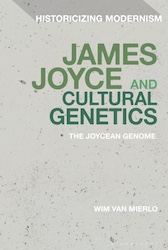
James Joyce and Cultural Genetics: The Joycean Genome
By Wim Van Mierlo
Bloomsbury Academic, 2023
Publisher’s Description: As a genetic study, this book uncovers the creative DNA of James Joyce’s oeuvre by looking at the cultural forces that shaped him and that he in turn shaped in the creation of his books, developing a two-way relationship with history, memory and national identity. Following his development as an author, it revisits and redirects Joyce’s attitudes towards the Irish Revival. From Chamber Music, through Ulysses to Finnegans Wake Joyce sought to define a cultural identity that went, in many respects, against the mainstream, but that nonetheless belonged to the wider Revivalist project with which it shared certain characteristics and aspirations. Joyce’s historical and genealogical imagination is read through a careful investigation of the cultural materials that went into his work. Based on evidence from his personal library and the extensive archive of reading notes, ideas, sketches and drafts, this book investigates how Joyce used, absorbed and repurposed these materials creatively in his writing; it does so by bringing for the first time the methods of genetic criticism into the domain of cultural memory and the sociology of the text. Thus this books defines “cultural genetics” as an exploration of the textual material that are Joyce’s sources interacts with the culture that produced and received them.
Genetic Joyce: Manuscripts and the Dynamics of Creation
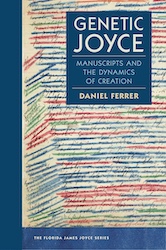
Genetic Joyce: Manuscripts and the Dynamics of Creation
By Daniel Ferrer
University Press of Florida, 2023
Publisher’s Description: This book shows how the creative process of modernist writer James Joyce can be reconstructed from his manuscripts. Daniel Ferrer offers a practical demonstration of the theory of genetic criticism, the study of the manuscript and textual development of a literary text. Using a concrete approach focused on the materiality of Joyce’s writing process, Ferrer demonstrates how to recover the process of invention and its internal dynamics. Using specific, detailed examples, Ferrer analyzes the part played by chance in Joyce’s creative process, the spatial dimension of writing, the genesis of the “Sirens” episode, and the transition from Ulysses to Finnegans Wake. The book includes a study of Joyce’s mysterious Finnegans Wake notebooks, examining their strange form of intertextuality in light of Joyce’s earlier forms of note-taking. Moving beyond the single author perspective, Ferrer contrasts Joyce’s notes alluding to Virginia Woolf’s criticism of Ulysses with Woolf’s own notes on the novel’s first episodes. Throughout this book, Ferrer describes the logic of the creative process as seen in the record left by Joyce in notebooks, drafts, typescripts, proofs, correspondence, early printed versions, and other available documents. Each change detected reveals a movement from one state to another, a new direction, challenging readers to understand the reasons for each movement and to appreciate the wealth of information to be found in Joyce’s manuscripts.
Genetic Inroads Into the Art of James Joyce
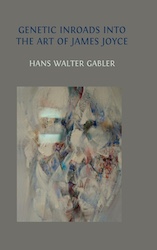
Genetic Inroads Into the Art of James Joyce
By Hans Walter Gabler
Open Book Publishers, 2024
Publisher’s Description: This book is a treasure trove comprising core writings from Hans Walter Gabler’s seminal work on James Joyce, spanning fifty years from the analysis of composition he undertook towards a critical text of A Portrait of the Artist as a Young Man, through the Critical and Synoptic Edition of Ulysses, to Gabler’s latest essays on (appropriately enough) Joyce’s sustained artistic innovation. Not only does this span of essays trace the evolution of Gabler’s thinking about Joyce’s originality and creative energy, it also reflects the development and maturation of Gabler’s own genetic criticism and his methodology of genetic editing, which grows in depth and complexity across the collection. The reader will explore Joyce’s life and works through Gabler’s incisive eye, while also examining a progress of his reflections on his edition of Ulysses and the past controversy that beset it. This classic compendium combining well-seasoned scholarship and fresh criticism is an essential read for critics of Modernism, digital humanists, scholars and students of James Joyce, and anyone interested in the art of literary analysis.
Joyce Criticism
[Main Page | General Criticism | Dubliners | Portrait | Ulysses | Finnegans Wake]
Author: Allen B. Ruch
Artwork: Loui Jover
Last Modified: 14 June 2024
Main Joyce Page: The Brazen Head
Contact: quail(at)shipwrecklibrary(dot)com

